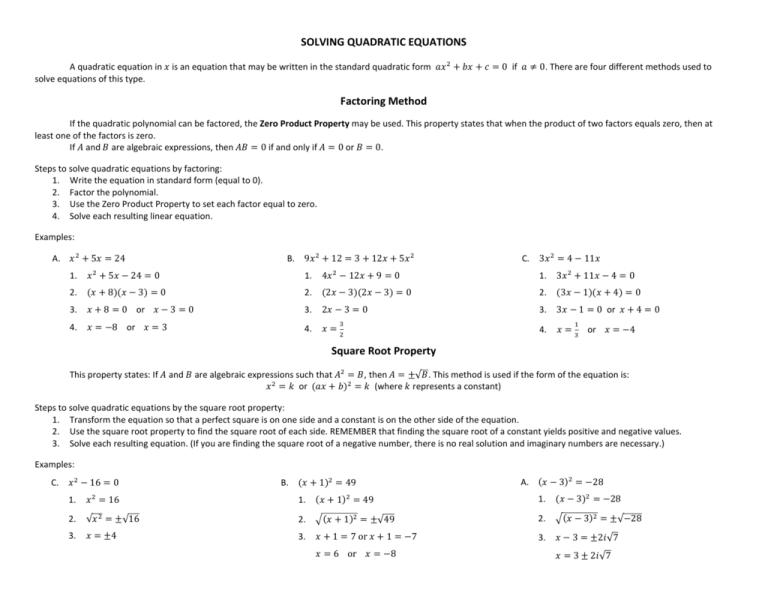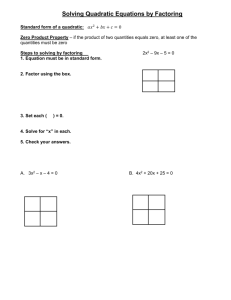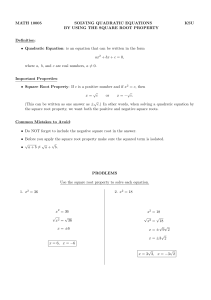SOLVING QUADRATIC EQUATIONS Factoring Method Square Root
advertisement

SOLVING QUADRATIC EQUATIONS A quadratic equation in is an equation that may be written in the standard quadratic form 0 if 0. There are four different methods used to solve equations of this type. Factoring Method If the quadratic polynomial can be factored, the Zero Product Property may be used. This property states that when the product of two factors equals zero, then at least one of the factors is zero. If and are algebraic expressions, then 0 if and only if 0 or 0. Steps to solve quadratic equations by factoring: 1. Write the equation in standard form (equal to 0). 2. Factor the polynomial. 3. Use the Zero Product Property to set each factor equal to zero. 4. Solve each resulting linear equation. Examples: A. 5 24 1. 2. 3. 4. B. 5 24 0 9 12 3 12 5 1. 8 3 0 2. 8 0 or 3 0 3. 8 or 3 4. 4 12 9 0 2 32 3 0 2 3 0 C. 3 4 11 1. 2. 3. 4. 3 11 4 0 3 1 4 0 3 1 0 or 4 0 or 4 Square Root Property This property states: If and are algebraic expressions such that , then √. This method is used if the form of the equation is: or (where represents a constant) Steps to solve quadratic equations by the square root property: 1. Transform the equation so that a perfect square is on one side and a constant is on the other side of the equation. 2. Use the square root property to find the square root of each side. REMEMBER that finding the square root of a constant yields positive and negative values. 3. Solve each resulting equation. (If you are finding the square root of a negative number, there is no real solution and imaginary numbers are necessary.) Examples: C. 16 0 1. 2. 3. 16 √ √16 4 B. 1 49 1. 2. 3. 1 49 1 √49 1 7 or 1 7 6 or 8 A. 3 28 1. 2. 3. 3 28 3 √28 3 2!√7 3 2!√7 Completing the Square This method may be used to solve all quadratic equations. ( 0, 0) Steps to solve an equation by completing the square: 1. Transform the equation so that the quadratic term and the linear term equal a constant. # % 2. Divide each term by the coefficient of the quadratic term if it is not a one. $ $ 3. Complete the square: # • Multiply the coefficient of by or divide it by 2. ( ) • • • 4. 5. # Square this value. & ' $ $ # # % # Add the result to both sides of the equation. & ' & ' $ $ $ $ Express one side of the equation as the square of a binomial and the other as a constant. & Use the square root property to find the square root of each side of the equation. Solve each resulting equation. # $ % # $ $ Examples: A. 12 2 0 B. 2 6 C. 2 8 15 0 1. 12 2 1. 2 6 1. 2 8 15 2. Lead coefficient is a one. 2. Lead coefficient is a one. 2. 4 3. 2 1 6 1 3. 4 4 3. 12 36 2 36 12 , - 36 2 6 34 4. 6 √34 4. 6 √34 1 √5 4. 1 !√5 5. 1 !√5 ( 2 1 5 6 √34 5. 2 , - 1 2 ' where is the constant formed by & ' . 2 ) 2 4 2 ) 5. ( √*+ 4 , - 4 2 Quadratic Formula The quadratic formula, which also may be used to solve any quadratic equation, results from solving the quadratic equation 0, 0 for by completing the square. √ 4 2 Examples: A. 6 16 B. 4 8 0 6 16 0 4 8 0 √ 4 2 6 6 4116 21 6 √100 2 6 10 2 2 or 8 √ 4 2 4 4 418 21 4 √48 2 4 4√3 2 2 2√3 Practice Problems 1. 2. 3. 4. 5. 6. 7. 8. 9. 10. 11. 12. 13. 14. 6 9 0 5 13 6 25 0 4 0 2 8 0 2 2 0 2 1 0 4 12 4 0 10 6 7 6 0 6 0 3 5 2 0 5. . 0 15. 16. 17. 18. 19. 20. 21. 22. 23. 24. 25. 26. 27. 28. 2 1 0 2 8 8 0 9. 6. 1 0 4 12 9 0 2 4 0 5 0 / / 1 0 2 0 1 0 0 20 7 0 1 0 4 4 5 0 3 4 7 ( 12 31 1 29. 30. 31. 32. 33. 34. 35. 36. 37. 38. 6 1 7 9 1 1 5 1 25 10 3 . +45 3// 5 16 / 4 1 0 3 31 3 2 1 0 4(7 6 1 4* 39. 1 40. 9 3 37 Practice Problems Answers 1. 3 2. 3 or 3. 5! 4. ( √( ! 7. 1 or 8. 2 2!√2 9. 11. 6 or 1 12. 3 or 2 14. . 0 or . ( 16. 2 18. 19. 1 √5 21. / 26. ! 27. 1 or 4√ √( 22. √2 8 28. 4 or 2 29. 9 33. / or / 2 34. 2 35. 36. √ 4√ 38. 6 4√+ 4(√8 * 39. 2! ( or 32. . 3 37. 17. . 20. 25. ! 31. 5 10. 3 ! 15. 1 24. 0 1 !√6 30. 6 or 1 4√8 13. 1 or √ ! 5. 4 or 2 6. 1 ! 23. 40. 3 !








